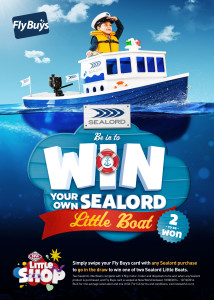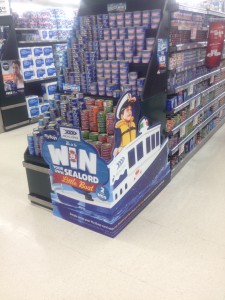Whilst taking a break from blogging, I’ve had the chance to focus on seeking out smart shopper programs to share. I came across one such program on a recent visit New Zealand, where I was speaking as the guest of Hypermedia and Geometry. During my trip I got the chance to meet up with the team at leading New Zealand’s seafood processor, Sealord. Sealord’s marketing director Sarah Sandoval and Geometry’s Louise Cunningham and Lina Montero Soto took me through a live shopper program they were running in conjunction with the New World chain of supermarkets.
A ‘little’ big idea

As with all great shopper programs this one began with a big idea: New World has secured a huge buzz from a collectable campaign called “Little Shop”. “Little Shop” rewards shoppers with miniature versions of the products they can buy in New World stores and these have become incredible popular with Kiwi kids. As Sealord and Geometry pondered how they could leverage this campaign, someone suggested a “little boat” might be just the vehicle needed to deliver “little” cans of Tuna to the “little store”.
From this a campaign was born – “Win Your Own Sealord Little Boat”. The little boats are scaled down replicas of two ships in the Sealord fleet and they’ve captured kid’s imagination across New Zealand. So enamored with the idea are New World that they’ve allowed Sealord to decorate some of their normally “clear aisles” with eye-catching point of sales materials.
Why “little boat” is such a smart shopper program
Successful shopper programs deliver on three levels; first they drive a change in shopper behavior that creates increased consumption; second, they profitably meet the company’s objectives and finally they meet the retailer’s objectives profitably too. ‘Little boat’ delivers on all three:
Changing shopper behavior
What’s interesting about this shopper program is that it spans a wide range of products within Sealord’s portfolio. Not only does it encourage shoppers to trade up from competitors to Sealord’s premium canned fish products but also it encourages them to buy high value chilled products like smoked salmon and indeed fresh fish at the seafood counter.
More that encouraging shoppers to buy though, the program also enables shoppers to buy. In many other categories we’ve seen that mums often find it hard to buy a healthy option for fear that children might reject it. In this case the volume of excitement amongst children for the competition may reduce their barriers to eating fish and may help mums to introduce more fish into the home.
As a result, this “little” shopper program may have a very profound impact on the diets of some families in New Zealand.
Delivering Sealord’s objectives profitably

It seems unlikely that this shopper program will fail to deliver incremental sales and the team should be bullish about the likely bounce in market share they’ll enjoy. Oftentimes however, well-oiled and well-engineered integrated campaigns deliver the bounce but not the RoI. Associated trade spend and media costs often eat up incremental profits. In this case, the support that has be secured at retail did not have to be bought because of the program’s fit with New World’s own strategy.
Further the social buzz that the campaign has created delivered major improvements in awareness without massive media investments. Whilst I have no idea what the financials are, I’m guessing that the RoI on this program will be both measurable and significant.
Delivering New World’s objectives profitably
The “little store” campaign that New World is running is undoubtedly targeted at drawing in more shoppers buying for young families. I’m certain the retailer is aiming to ensure that shoppers not only return to New World’s stores but also spend more whilst there. “Little boat” delivers these on all these levels. Why?
- It’s an exclusive offer that drives traffic to New World alone;
- It’s a reason for shoppers to return to New World, and;
- (Best of all) It encourages shoppers to buy premium products.
All considered, New World should be seeing a considerable upside in some important grocery categories, enjoying a solid halo effect from social chatter and acquiring market share from competitors. With low to no investment cost from New World to run the campaign, I would hope they are delighted!
Is this a perfect shopper program?
Like all retail campaigns there are some issues in execution but considering that New World generally rejects all but its own in-store communication, I think this is to be expected. For me I’d give it a solid 9 out of 10 and I think a huge amount of credit is due to the teams at Sealord and Geometry for delivering on so many levels.
I’ll be looking to share more cases over the coming months, so please feel free to connect if you have a shopper program you’d like me to share.